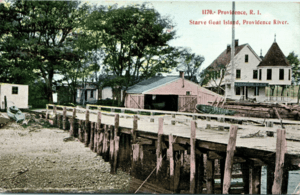Starvegoat Island facts for kids
Starvegoat Island was a small island located in the Providence River in Providence, Rhode Island. It was also known as "Sunshine Island" on some maps from the 1920s. This island was the most southeastern point in the city of Providence. For many years, it was famous for its oyster fishing.
Contents
Starvegoat Island: A Lost Landmark
Starvegoat Island was once a real place in the Providence River. It was a small piece of land that stood out in the water. The island's name, "Starvegoat," might sound a bit funny, but it was a well-known spot for people living in Providence.
Where Was Starvegoat Island Located?
Starvegoat Island was found in the Providence River. This river flows through the city of Providence, Rhode Island. The island was very close to a place called Fields Point. It was the most southeastern part of Providence city. Maps from the past, like one made by the US Army Corps of Engineers in 1927, even called it "Sunshine Island."
What Was Starvegoat Island Known For?
For a long time, from the 1800s into the early 1900s, Starvegoat Island was important for oystering. This means people would collect oysters from the waters around the island. Oysters were a valuable food source and a part of the local economy.
What Happened to Starvegoat Island?
Starvegoat Island no longer exists as a separate island today. During the 1950s and 1960s, the area between the island and Fields Point was filled in. This was done to create more land, often using it as a landfill. A landfill is a place where trash is buried. Over time, the passage of water that separated the island from the mainland disappeared.
Starvegoat Island Today
Today, the approximate area where Starvegoat Island once stood is home to an educational center. This center is run by an organization called Save the Bay. One of the cool things they do there is recreate a natural coastal buffer zone. This helps protect the coastline and provides a home for wildlife. So, while the island itself is gone, its location is now used for important environmental education.


